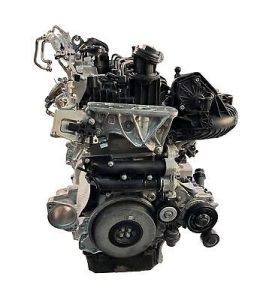In the world of car engines, there are two main types of air intake systems: naturally aspirated and forced induction. Today, we’re diving deep into the world of naturally aspirated engine. These engines rely on atmospheric pressure alone to draw air into the cylinders, creating a simpler and more predictable power delivery system.
Understanding the Basics of a Naturally Aspirated Engine
Imagine taking a deep breath. That’s essentially how a naturally aspirated engine works. During the intake stroke of a four-stroke cycle, the piston moves down in the cylinder, creating a low-pressure area. This low pressure draws air, along with fuel, into the combustion chamber through an open intake valve. Once the piston reaches the bottom of the cylinder, the intake valve closes, trapping the air-fuel mixture. The piston then begins to move back up, compressing the mixture. At the peak of compression, a spark plug ignites the mixture, creating a small explosion that drives the piston back down, generating power. Finally, the exhaust valve opens, and the spent gases are expelled as the piston rises again, completing the cycle.

The beauty of a naturally aspirated engine lies in its simplicity. There are no complex components like turbochargers or superchargers to force air into the engine. This simpler design translates to several advantages:
- Easier Maintenance: With fewer moving parts, naturally aspirated engines are generally easier and less expensive to maintain than their forced-induction counterparts.
- Lower Production Costs: The lack of complex forced induction systems makes naturally aspirated engines more affordable to produce, which often translates to lower sticker prices for vehicles equipped with them.
- Improved Reliability: Fewer components mean less chance of something breaking down. Naturally aspirated engines are known for their reliability and durability.
- More Predictable Power Delivery: Unlike turbocharged engines that can experience a lag in power delivery (turbo lag), naturally aspirated engines offer a more linear and predictable powerband, making them easier to control for drivers of all skill levels.
Naturally Aspirated vs. Forced Induction: A Tale of Two Engines
While naturally aspirated engines offer several advantages, they also come with some limitations. The primary drawback is their power output. Because they rely solely on atmospheric pressure to draw in air, they are generally less powerful than forced-induction engines of similar displacement.
Forced-induction engines, like turbocharged and supercharged engines, use additional components to force more air into the cylinders than atmospheric pressure allows. This extra air enables them to generate more power, making them ideal for performance-oriented vehicles.

However, the added complexity of forced-induction systems comes at a cost. They tend to be more expensive to maintain and repair, and they can experience issues like turbo lag, which can make power delivery feel less responsive.
So, which type of engine is right for you? If you prioritize affordability, ease of maintenance, and a predictable driving experience, a naturally aspirated engine might be the perfect choice. However, if raw power and acceleration are your top concerns, a forced-induction engine might be a better fit.
Optimizing Performance in Naturally Aspirated Engines
Despite their limitations on raw power, there are ways to optimize the performance of naturally aspirated engines. Here are a few key strategies:
- Increase Engine Displacement: Engine displacement refers to the total volume of the cylinders. By increasing the displacement, you create more space for air and fuel, allowing for more power generation. This is often achieved by using larger cylinders or adding more cylinders altogether.
- High-Performance Air Intake Systems: Upgrading the air intake system with a high-flow air filter and a less restrictive intake manifold can improve airflow into the engine, leading to a slight power increase.
- Lightweight Components: Reducing the weight of the vehicle allows the engine’s power to be used more effectively, resulting in better acceleration and handling.
- Performance Camshafts and Valve Springs: Camshafts and valve springs control the timing and duration of valve opening. Upgrading these components to more aggressive profiles can improve airflow and optimize engine performance at higher RPMs.
The Allure of Naturally Aspirated Engine: Beyond Power Numbers
While horsepower and torque figures might be the first things that come to mind when discussing engines, there’s more to the story with naturally aspirated engines. They offer a unique driving experience that often resonates with car enthusiasts:

- Linear Power Delivery: The predictable and linear powerband of a naturally aspirated engine makes it easier to control and provides a more connected feeling to the car’s performance.
- Engaging Revving Experience: Naturally aspirated engines often have a higher redline (maximum RPM) compared to forced-induction engines. This allows drivers to explore the full potential of the engine and experience the thrill of high-RPM performance.
The Future of Naturally Aspirated Engine: Evolution, Not Extinction
Despite the rise of forced induction technologies, naturally aspirated engines aren’t going anywhere anytime soon. Here’s why:
- Focus on Fuel Efficiency: As automakers strive to meet increasingly stringent fuel economy standards, naturally aspirated engines remain a valuable weapon in their arsenal. Their simpler design often translates to better fuel efficiency, especially in smaller and lighter vehicles.
- Advancements in Technology: Even without forced induction, engineers are constantly innovating ways to improve the performance and efficiency of naturally aspirated engines. Variable valve timing, direct injection, and lightweight materials are just a few examples of technologies that are helping naturally aspirated engines stay competitive.
- Hybrid Synergy: The combination of a naturally aspirated engine with an electric motor in a hybrid powertrain can create a remarkably fuel-efficient and powerful driving experience. The electric motor can provide instant torque and assist the engine during acceleration, while the naturally aspirated engine offers efficient cruising capabilities.
Are Naturally Aspirated Engine Right for You?
Choosing between a naturally aspirated engine and a forced-induction engine boils down to your priorities. Here are some questions to consider:

- Budget: Naturally aspirated engines are generally more affordable to purchase and maintain.
- Driving Style: If you prioritize a predictable and engaging driving experience, a naturally aspirated engine might be ideal.
- Fuel Efficiency: For fuel-conscious drivers, a naturally aspirated engine can be a good choice, especially when paired with fuel-saving technologies.
- Performance Needs: If raw power and acceleration are your top needs, a forced-induction engine might be a better fit.
Ultimately, the best engine type depends on your individual needs and preferences. Take some time to test drive vehicles equipped with both naturally aspirated and forced-induction engines to see which one feels more comfortable and enjoyable for you.
Keeping Your Naturally Aspirated Engine Running Strong
Naturally aspirated engines are known for their reliability, but proper maintenance is still essential. Here are some key tips:

- Regular Oil Changes: Follow your vehicle’s recommended oil change intervals to ensure proper lubrication and engine protection.
- Air Filter Maintenance: A clean air filter allows for optimal airflow and prevents dirt and debris from entering the engine. Replace your air filter according to the manufacturer’s recommendations.
- Spark Plug Care: Worn-out spark plugs can lead to misfires and decreased performance. Replace your spark plugs at the recommended intervals.
- Fuel System Cleaning: Regularly cleaning your fuel system can help prevent deposits from building up and hindering performance.
By following these simple maintenance tips, you can ensure your naturally aspirated engine runs smoothly and efficiently for years to come.



